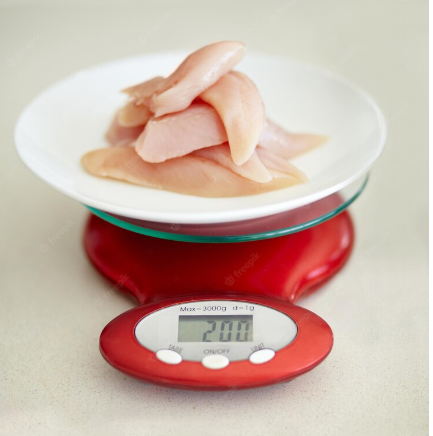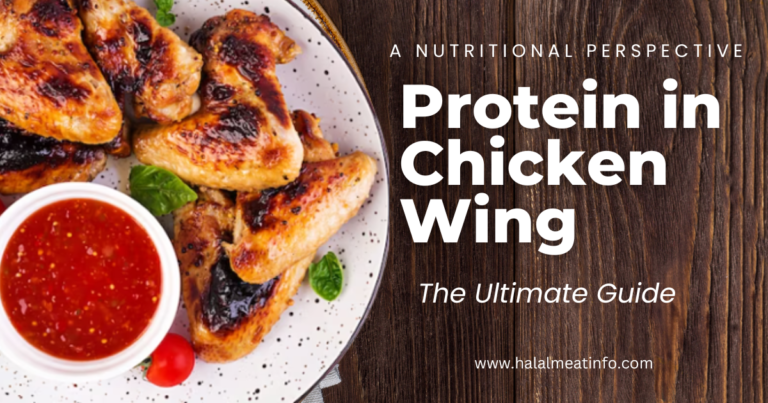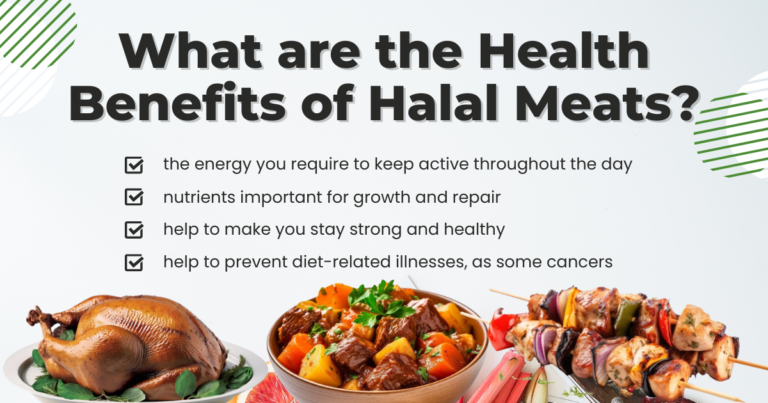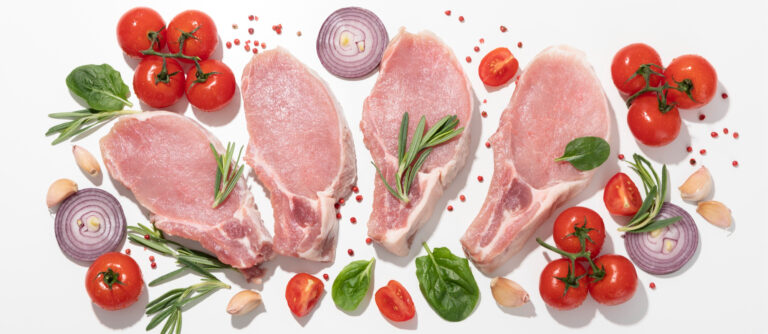How Much Protein in Chicken Breast? Here’s All You Need To Know
Welcome to our nutritional guide, where we explore and elucidate the contents of everyday food items. Today, we focus on a key ingredient that forms the cornerstone of many a healthy diet – the humble chicken breast. Chicken breast is a popular and versatile protein source that is commonly consumed by individuals seeking to meet their protein requirements. Chicken breast is a favorite among health-conscious eaters and athletes because of its high protein content and low-fat content. But how much protein is packed into a single serving of this versatile meat? Let’s delve in and find out.

What is Protein?
Protein is one of the three macronutrients, along with carbohydrates and fats that our bodies require in relatively large amounts. It is composed of smaller units called amino acids, which are the building blocks of protein Twenty distinct amino acids can combine in a variety of ways to generate diverse types of proteins. Our bodies can produce some amino acids, but others must be obtained from our foods, making them essential amino acids.
Understanding the Importance of Protein:
Protein is a significant building block of the human body, playing a crucial role in the growth and repair of tissues. From our skin and hair to our muscles and organs, protein is a vital component that ensures our body functions optimally.
How Many Grams of Protein in a Chicken Breast?
The amount of protein in a chicken breast can change based on how big it is and how it is cooked. On average, a raw, skinless chicken breast weighing around 172 grams (6 ounces) provides approximately 54 grams of protein. This is based on the fact that chicken breast generally contains 31.2 grams of protein per 100 grams.
But it’s important to remember that grilling, baking, or frying can slightly change the amount of protein. Additionally, the way the chicken is raised (organic, free-range, conventional) and the part of the chicken (white meat vs. dark meat) can also influence the protein content. So, the best way to find out how much protein something has is to look at the label or use a trusted food database. This makes it an ideal ingredient for those seeking to build muscle, lose weight, or simply maintain a healthy diet.
Chicken Breast Protein Content
Chicken breast provides an impressive amount of protein. This poultry part can be a significant contributor to reaching your daily protein needs.

1oz Chicken Breast Protein
A 1-ounce serving of cooked chicken breast provides approximately 7 grams of protein. This makes it a convenient protein source for those who prefer smaller meals or need to increase their protein intake without consuming a large quantity of food.
2oz Chicken Breast Protein
Double the size, double the protein. A 2-ounce serving of cooked chicken breast equates to nearly 14 grams of protein. This size of serving is great for people who are watching how many calories they eat but still want to get enough protein.
3oz Chicken Breast Protein
A 3-ounce serving of cooked chicken breast, the standard serving size for most dietary guidelines, packs a whopping 22 grams of protein. This portion size can effectively contribute to muscle building and repair, making it a popular choice among athletes and fitness enthusiasts.
4oz Chicken Breast Protein
Stepping up to a 4-ounce serving of cooked chicken breast, you are looking at an impressive 29 grams of protein. This amount not only covers a significant portion of daily protein requirements for most individuals but also aids in maintaining a healthy weight and supporting the immune system.
5oz Chicken Breast Protein
A 5-ounce serving of cooked chicken breast provides you with an abundant 36 grams of protein. This generous amount can support muscle recovery after strenuous workouts and promote fullness. Which can help in managing weight by reducing overall calorie intake.
6oz Chicken Breast Protein
For those with higher protein needs, a 6-ounce serving of cooked chicken breast offers a substantial 43 grams of protein. This hefty serving can be especially beneficial for individuals involved in intense physical activities, such as weightlifting, or for those looking to add lean muscle mass.
7oz Chicken Breast Protein
If your dietary needs require a more substantial protein intake, a 7-ounce serving of cooked chicken breast provides a hearty 50 grams of protein. This portion is ideal for those who need a high-protein diet, such as bodybuilders or people recovering from surgery.
8oz Chicken Breast Protein
As we increase the serving size to an 8-ounce portion of cooked chicken breast, you are provided with a tremendous 57 grams of protein. This protein-packed portion is perfect for athletes who require high protein levels for optimal performance and recovery. It can also be beneficial for those on a weight loss regimen, as it promotes satiety, helping to curb cravings and prevent overeating.
Nutritional Value
In addition to its impressive protein content, chicken breast offers a variety of other nutrients. These include essential vitamins such as vitamin B6 and niacin, which support energy production and nervous system health. Furthermore, it provides minerals like selenium and phosphorus, which play key roles in antioxidant defense and bone health, respectively. No matter your dietary preference or health goals, chicken breast is a versatile and valuable addition to any meal plan.
Protein Content Variation in Chicken Breast:
Raw vs. Cooked Chicken Breast
The protein content of chicken breast can be affected by the cooking process. Exploring the changes in protein content during cooking and learning tips for retaining protein content can assist individuals in optimizing their protein intake from chicken breast.
Different Cuts of Chicken Breast
Different cuts of chicken breast, such as skinless versus skin-on or bone-in versus boneless, can impact the protein content. Understanding these variations can help individuals make appropriate choices based on their nutritional needs and preferences.
Factors Affecting Protein Absorption and Utilization:
There are several factors that impact how our bodies absorb and utilize proteins from foods like chicken breasts.

- Digestive Health: Proper function of the digestive system is crucial for protein absorption. Protein absorption can be hampered by a variety of conditions, including inflammatory bowel disease (IBD), celiac disease, and chronic pancreatitis.
- Age: As we age, our bodies become less efficient at absorbing and utilizing protein, making it crucial for older adults to consume ample amounts of high-quality protein.
- Physical Activity Level: Regular exercise enhances the body’s ability to utilize protein. Athletes or those participating in regular intense physical activities often require more protein.
- Diet Composition: Consuming a variety of foods ensures an intake of a wide range of amino acids (the building blocks of protein). Diets lacking in diversity may not provide all the necessary amino acids.
- Meal Timing: Consuming protein-rich foods after a workout can improve protein synthesis and muscle recovery.
By understanding these factors, we can adopt dietary strategies that optimize protein absorption and utilization, ensuring we reap the full benefits of prote
Protein Recommendations and Serving Size

Recommended Daily Intake of Protein
Protein needs vary by gender, but the RDA ( Recommended Dietary Allowance) for women is 46 grams and for males, it’s 56 grams. Age, gender, and exercise level are all potential moderators of this. It’s crucial to remember that our bodies need a regular supply of protein as it does not store it like fats and carbohydrates.
Protein Content in a Serving of Chicken Breast
A standard serving of chicken breast, which is about 3 ounces or 85 grams, provides around 26 grams of protein. This means that one serving of chicken breast can provide around half of the daily protein requirement for most people.
Serving Sizes and Frequency
The serving size and frequency of chicken breast consumption will depend on individual nutritional needs and health goals. Athletes and those engaged in heavy physical activities may benefit from larger serving sizes or more frequent servings to meet their higher protein requirements.
Calculating Individual Protein Needs
To calculate your individual protein needs, you can use the general guideline of consuming 0.8 grams of protein per kilogram of your body weight. This calculation can help you determine the quantity of chicken breast or any other protein source you should consume daily. However, personal factors like health status, age, and physical activity level should also be taken into account.
Protein Intake and Balanced Diet
Even though chicken breast is a great way to get high-quality protein, a well-rounded diet is still essential. Including a variety of protein sources such as fish, lean meat, dairy, and plant-based proteins alongside chicken breast ensures a good mix of nutrients and aids overall health and well-being.
Incorporating Chicken Breast into a Balanced Diet
Choosing Healthy Cooking Methods
When making chicken breast, it’s important to use healthy cooking methods that keep the chicken’s nutritional value and keep the amount of unhealthy fats to a minimum. Grilling, baking, and steaming are the best ways to retain the maximum nutritional value.
Pairing Chicken Breast with Nutrient-Rich Foods
You can make a well-rounded dinner that’s strong in protein, fiber, and critical nutrients by pairing chicken breast with a range of veggies, whole grains, and healthy fats. For instance, pairing grilled chicken breast with a quinoa salad and a side of steamed veggies makes a nutrient-rich meal.
Portion Control
Maintaining an appropriate serving size is key to enjoying chicken breast as a part of a balanced diet. A single serving size is typically 3 ounces (85 grams), which provides roughly 26 grams of protein. Modify according to your daily protein intake and dietary habits.
Use a Variety of Protein Foods
It is a high-quality protein source. It’s important to diversify your protein sources to ensure you’re getting a broad spectrum of essential nutrients. Include in your diet a variety of protein sources, including lean meats, dairy products, seafood, and plant-based proteins like lentils, beans, and tofu.
Frequency of Consumption
The frequency with which you consume chicken breast can vary depending on individual health goals and dietary needs. However, a balanced diet should include a range of protein sources consumed throughout the week.
Benefits of Chicken Breast in Human Health
Chicken breast is not only beneficial for weight loss, but it also packs a punch for overall human health. One of the key nutrients present in chicken breast is Vitamin B6, which plays a crucial role in brain development and function and aids in the synthesis of hormones like serotonin and norepinephrine, which influence mood. In addition, it contains high levels of selenium, a mineral vital for immune system health and protection against oxidative stress. Chicken breasts also boast a high niacin content, a type of B vitamin that may reduce the risk of cardiovascular disease. To top it all, the high-quality protein in chicken breast is vital for maintaining healthy skin, hair, and nails, as well as repairing tissues and muscle recovery. The chicken breast in a balanced diet can thus contribute significantly to overall health and well-being.
Conclusion:
In conclusion, It is a great source of high-quality protein, delivering a substantial amount of the daily needs in a single meal. Its lean nature and versatility make it a valuable inclusion in any balanced diet. However, it’s equally important to remember that protein absorption and utilization by the body can be affected by various factors. These factors, including digestive health, age, physical activity level, diet composition, and meal timing. By understanding these elements, we can develop dietary strategies that optimize protein intake and overall health. Balancing our protein sources, incorporating a variety of nutrient-rich foods, and selecting healthy cooking methods are essential components of a well-rounded dietary approach. Ultimately, a diversified diet is the key to obtaining a broad spectrum of essential nutrients and promoting overall health and well-being.
FAQ’s
Protein needs vary by gender. According to RDA ( Recommended Dietary Allowance) for women is 46 grams and for males, it’s 56 grams. Furthermore, Age, gender, and exercise level are all potential moderators of this
It is about 3 ounces (85 grams), provides around 26 grams of protein.
A good rule of thumb for figuring out how much protein a person needs is to eat 0.8 grams of protein for every kilogram of body weight. But things like your health, age, and level of physical activity should be taken into mind.
You can incorporate chicken breast into a balanced diet by pairing it with a variety of vegetables, whole grains, and healthy fats. Maintain an appropriate serving size and diversify your protein sources to ensure a broad spectrum of essential nutrients.
Grilling, baking, and steaming are considered healthier cooking methods for chicken breast as they preserve its nutritional value while minimizing the addition of unhealthy fats.
The frequency of chicken breast consumption varies based on individual health goals and dietary needs. It is generally recommended to consume a variety of protein sources throughout the week for a well-rounded diet.
References:
- https://www.emerald.com/insight/content/doi/10.1108/NFS-12-2021-0384/full/html
- https://pubmed.ncbi.nlm.nih.gov/16002798/
- https://www.ncbi.nlm.nih.gov/pmc/articles/PMC3518828/
- http://nutritiondata.self.com/facts/poultry-products/703/2
- https://www.mdpi.com/2072-6643/8/6/359
- https://royalsocietypublishing.org/doi/full/10.1098/rstb.2016.0523






